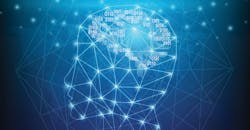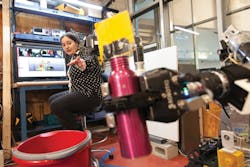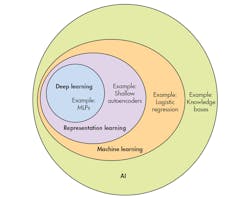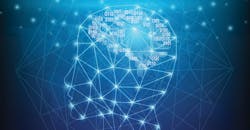Can Machine Learning Turn Big Data into No Big Deal?
Download this article in PDF format.
With technology moving so fast, new ways to automate, and connected machines, how can managers and engineers simplify the complexity of that ecosystem? Is machine learning (ML) or artificial intelligence (AI) the key? This article will define some buzzwords, what they mean, and if they might help simplify these complex technologies so that you can move back into production.
New technologies, such as Big Data and the Industrial Internet of Things, are gaining more traction. While security is a concern, some companies push ahead because the benefits are too great. In "Machine Learning Techniques in Manufacturing,” published by Dell, it mentions that organizations actively using data, such as data from the IIoT or ML, grew 50% faster than companies that didn’t. However, the number of organizations that understand the importance of Big Data only grew by 3% from 2013 to 2014. Since 2014, that number has likely improved, but this serves as an example of the adoption rate or just a few years ago.
With so many buzzwords and some sales forces only focused on what’s lining their pockets, where do you start? First, the term Industrial Internet of Things (IIoT) is just that—things connected through the internet. IIoT can represent Industry 4.0, and potentially smart devices (devices that use sensors to generate data, but may not necessarily send that data over the internet). The idea is that the IIoT is connecting devices to the internet to get data where it’s needed.
However, the term IIoT has started bleeding into non-internet connected devices that might occur on a closed network, such as communication between machines, known as machine-to-machine (M2M), or Bluetooth communications. While M2M and smart devices don't have to include the internet, they have all blended into the IIoT terminology.
Similarly, AI and machine learning seem to have bled into one another. "Under AI, there are a lot of different technologies, some of them exist and function, others are not yet mature, others are simply buzzwords,” says Matteo Dariol, senior solution architect at Bosch Software Innovations. “In my experience, in real-world manufacturing, I have not heard of anyone using AI for operations. It is more plausible that R&D centers are studying and testing certain algorithms. Some industrial components like PLC, drives, motors, already include certain neural networks that could fall under the wide umbrella of AI; typical applications are providing more energy efficiency or quicker reaction time."
A neural network operates similar to a human brain. There are many connections, and through experience, we can learn to identify shape, colors, and how other objects interact with them. Offering this type of extensive connectivity to a manufacturing plant is sometimes referred to as “deep learning.” With this kind of AI, a computer can learn or figure things out on its own. It sounds great, but when manufacturing talks about AI, it is normally programmed or supervised. Called “weak AI,” it will respond to how it is programmed, and not make decisions on its own. To simplify keyword overlap, this article will refer to a loosely translated IIoT, and not talk about AI or deep learning.
“By combining the intuitiveness of learning from demonstration with the precision of motion-planning algorithms, this approach can help robots do new types of tasks that they haven’t been able to learn before, like multistep assembly using both of their arms,” says MIT grad student Claudia Pérez-D'Arpino (Photo courtesy of Jason Dorfman/MIT CSAIL)
IIoT can be as simple as communicating over a network, which has been done for a long time. So what has changed? The software is becoming more sophisticated, and the hardware is smaller and consumes less energy, yet overall prices have dropped.
For example, people have been talking about Wi-Fi since the 1990s, but it was the price drop that allowed it to grow. Today, Wi-Fi is something we don't seem to question. Until some of the technologies, such as ML, mature to where it's a no-brainer, early adopters will have to leverage new technology in a strategic way to gain a competitive edge to justify the cost.
Strategic IIoT
Determining what is critical to measure is the first step in constructing an IIoT system. Next is finding a way to connect devices for the lowest cost with the easiest integration possible. Many people talk about predictive maintenance to reduce downtime because that seems to be the low-hanging fruit. However, even low-hanging fruit can cause headaches.
Open source is now viewed as an important step toward future-proofing and to ensure compatibility across a production lines, the manufacturing floor, and a company as a whole. But getting human-machine-interface (HMI), and supervisory-control and data-acquisition (SCADA) data where it needs to be might interfere with legacy software or firmware that is proprietary.
“This can cause serious compatibility issues, limit the available options, and lock an integrator and their client to one software vendor,” says Dariol. “The latter issue can become especially serious if a vendor goes out of business or stops supporting a product.”
“In a customer survey conducted by Bosch Software, 61% of our respondents said software is the greatest pain point, while 21% said hardware, and 18% cited other issues. The main issues cited were software compatibility, limited selection, complexity, training, and support,” says Dariol. This is one reason industry has been favoring software solutions grounded in open, IT-standard technologies from vendors with a history of successful industrial implementations.
The IIoT Singularity
Another problem with legacy equipment is whether they collect data at all. Companies have worked on many ways to offer plug-and-play sensor packages to collect information, with multiple options to send it where ever it needs to go. For example, Bosch Connected Devices and Solutions’ XDK is a sensor package with a battery and software that acquires data from operations that otherwise don't offer it. Various systems like this are available on the market and they’re great, but may require extra steps to get the data to a single or shared location.
This Venn diagram, which appears in the book Deep Learning (MIT Press), helps illustrate how deep learning, machine learning, and representation learning are all a part of artificial intelligence.
Plug-and-play solutions may help with IIoT low-hanging fruit, but make sure this data has a way to connect with other systems. More advanced connectivity leads to more complex systems. Therefore, do yourself a favor and make sure you can link everything to a singular location, or that everything is compatible with each other for data-sharing purposes. This will simplify the system, and for many companies, access in one location means cloud connectivity.
Putting everything in a single location—cloud or otherwise—might facilitate a hacker’s ability to corrupt a system. However, modern security practices such as segregation, firewalls, and encryption are generally available and work well to keep all of the data in one location while providing an acceptable level of security.
IIoT to Machine Learning
Though security will be of greater concern as a company becomes more connected, expanding the IIoT is the only way to take advantage of ML. Collecting more data for predictive maintenance or decision-making can result in higher confidence and accuracy. The ability to learn, find patterns, or make decisions accurately is also known as Big Data. As is the case with statistics, ML or Big Data requires an appropriate n-value or sample size.
ML will inevitably mean larger integration than the low-hanging-fruit model, and is likely to experience growing pains. ML can improve predictive maintenance by having a system notice correlations not perceived by a human. Pooling all of the data in a single location can make correlations beyond predictive maintenance, too. Production information can help managers make decisions on inventory, logistics, sales, and more. To reap the benefits of a higher-performing data network such as IIoT, ML, or Big Data, an interdisciplinary communication network is essential.
IoT of People
Connecting and communicating with machines and between machines carries a lot of value. However, we still need to communicate as humans. There’s often a divide between operational technology (OT) and Information technology (IT).
“OT professionals are focused on keeping manufacturing, plant, and physical equipment in operation for extended periods of time, while IT professionals focus on keeping data flowing and accessible to all facets of an organization,” says Dariol. “Because OT and IT have distinctively different requirements, their solutions also differ. OT solutions tend to be restrictive and proprietary, slow to adapt, whereas IT solutions are generally more open, fast moving, and cutting edge.
“IT and OT are two different worlds, even when dealing with problem-solving approaches. IT people use more frequently a top-down approach, starting from the big picture, business requirements, and then identifying smaller isolated tasks that can be completed in parallel and then put back together – a “divide et impera” principle,” continues Dariol. “On the other hand, OT often refers to a bottom-up approach, dealing first with small components such as sensors, cables, actuators, then extending their requirements to fieldbus protocols, up to controllers, cells, lines and plants. The divide presents a great opportunity for OT and IT to come together and leverage each other’s strengths to deliver a truly disruptive technology. To keep OT and IT separate is an outdated, pre-IIoT mindset that will not allow industrial organizations to be competitive going forward. To meet the demands of today’s data-intensive environment, enterprises must work to align OT and IT."
Generally, OT will often have more resistance to change if there’s a bigger investment without a definite ROI. What will help justify cost, or help IT gain more support, is to expand this thought further. ML is expanding to sales, marketing, and other departments; it is important that each understands the big picture and where they fit in it. This will help determine how to adjust and improve ML. Human involvement is an interesting twist on advanced automation— having a person somewhere in the line will improve performance.
MIT recently published the article “Teaching robots to teach other robots,” in which it mentions if an operator approved or adjusted a robot’s automatically derived motion plans, it improves the success rate. The robot, when left alone, had a success rate of 87.5%. Success increased to 100% when a human made minor corrections from inaccurate sensor data. In ML, the people can hone a system over time to aid the software in making corrections or learning. It’s akin to a professor letting students figure things out for themselves, while occasionally jumping in to push students back on track when needed.
By collecting all of the data, communicating between departments, and keeping an eye on what the machine is learning, engineers don't need to determine what is critical to measure, or what data is required for better maintenance or better decision making. By collecting all the data, algorithms will find patterns, determine what information show correlations, and present a logical prediction or extrapolations of the correct actions to be as effective as possible.
Machine-Learning Benefits
Currently, predictive maintenance is a large focus that can reduce downtime and improve production rates. Once you have a large-enough connected network, it is possible to use the production rates and other data to optimize the supply chain and resources. According to Forbes, over 70% of complex manufacturers are relying on outside suppliers that make decisions on which buyer’s order will be filled first.
ML allows for better collaboration between buyer and supplier. This information and improved communication will help better manage inventory. Finally, this data can extend to the sales department. Sales can throttle prices to ensure they are offering the right price with the best margin based off of logistics, inventory, and a more accurate delivery date without causing backups.
The article “Sales Gets a Machine-Learning Makeover,” published by MIT, states that “76% of respondents said they are targeting higher sales growth with ML, the kind of artificial intelligence software that continuously learns from Big Data and optimizes recommendations in real time to sales staff. Moreover, more than two out of five companies have already implemented ML in sales and marketing … 38% of respondents credited ML for improvements in their key performance indicators for sales—such as new leads, upsells, and sales cycle times—by a factor of 2 or more, while another 41% created improvements by a factor of 5 or more.”
This is why procuring all of the data can improve business as a whole—even if it isn’t the engineering department. This is only possible through the analytics and algorithms that turn numbers into sense. As machines come closer to mimicking humans, we must consider the following:
- A plan that can answer the who, what, why, where, and how your manufacturing can stay competitive, which will probably lead you down some path of using data and more of it.
- Keep your hardware, software, and vendors grounded in open IT standard technologies, while maintaining a high level of security.
- Focus on compatibility and future needs to ensure everything can communicate to each other, and collaborate in the same space.
- Know where you need people to intervene, and what knowledge and skills they will need to guide a robot, production line, or sales in the right direction.
- Don’t be taken in by buzzwords. Generally, they’re all just different networks or programs. A company should be able to communicate things to you in a common language. Collaboration is key, but communication must be clear whether it is between hardware, software, employees, or outside vendors.
Overall, AI, Big Data, IIoT, and machine learning will require some human involvement or thought. These technologies are intertwined with manufacturing and your ROI. If you want to compete, you need to educate yourself and look for people with skill centered on these data-driven technologies. Faster communication and processing of communication has always won—letters were taken over by the telegraph, the telegraph was taken over by the phone, and the phone was taken over by the internet. Don’t let your company end up in the museum.




